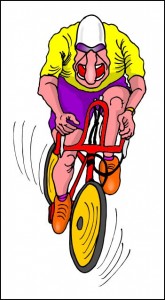Eppie’s Great Race and Tour de France
 Every year, around late June, I begin noticing a special kind of cyclist on the American River Parkway. Their typical equipment is spotlessly new or, as often, coated with a year’s worth of garage dust.
Every year, around late June, I begin noticing a special kind of cyclist on the American River Parkway. Their typical equipment is spotlessly new or, as often, coated with a year’s worth of garage dust.
These riders are strangely intense–hitting curves at speeds testing their abilities, their faces in full grimace. Runners, leisurely cyclists, and elderly bird watchers are often shouted off the pavement as these frenzied cyclists whoosh past.
Usually, after several encounters with these strangely intense riders, I slap my head in remembrance. Eppies! Of course.
And probably adding to their intensity is each day’s installment of Le Tour, waiting at home on the DVR.
Well now The Great Race has come and gone and the Parkway is back to its usual population of generally polite runners, walkers, and cyclists.
Truthfully, most of the cyclists training for Eppies are nice enough, and it’s good they’re out there–even if only for a few weeks. In these days of budget cuts and sketchy law enforcement, the Parkway needs all the friends and allies it can find.
By August, I’m missing all those bicyclists and wishing they’d stick around the rest of the year and learn the rules and learn to love the trail like those of us who spend so much of our free time out there. There is plenty of room for everyone.
If you are looking for results from Eppies, you can find them here.
There is a Sacramento Bee article, too. (It includes the annual photo of kayaks collecting at the finish.)
In case I lured you into this post by a reference to the Tour de France, you should check out this interesting analysis at the Science of Sport of whether the slower mountain climbs are due to improved doping controls.
Another version of this story (A Doping Free Tour de France?) was in Saturday’s New York Times. In this article, the same writers (Ross Tucker and Jonathan Dugas) give a less “sciencey” explanation of the observations that were made in the final climbs of the race. Interesting and hopeful reading!
